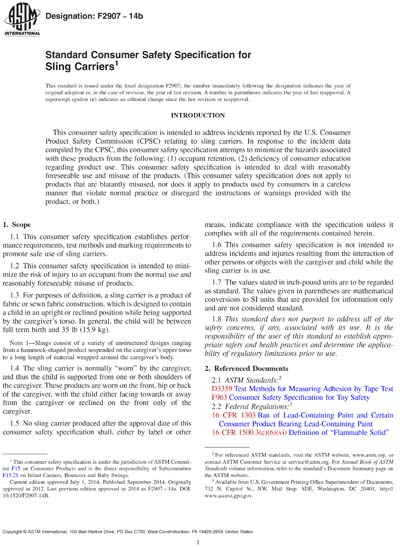Historical
ASTM F2907-14b
Standard Consumer Safety Specification for Sling Carriers
1.1 This consumer safety specification establishes performance requirements, test methods and marking requirements to promote safe use of sling carriers.
1.2 This consumer safety specification is intended to minimize the risk of injury to an occupant from the normal use and reasonably foreseeable misuse of products.
1.3 For purposes of definition, a sling carrier is a product of fabric or sewn fabric construction, which is designed to contain a child in an upright or reclined position while being supported by the caregiver’s torso. In general, the child will be between full term birth and 35 lb (15.9 kg).
Note 1: Slings consist of a variety of unstructured designs ranging from a hammock-shaped product suspended on the caregiver’s upper torso to a long length of material wrapped around the caregiver’s body.
1.4 The sling carrier is normally “worn” by the caregiver, and thus the child is supported from one or both shoulders of the caregiver. These products are worn on the front, hip or back of the caregiver, with the child either facing towards or away from the caregiver or reclined on the front only of the caregiver.
1.5 No sling carrier produced after the approval date of this consumer safety specification shall, either by label or other means, indicate compliance with the specification unless it complies with all of the requirements contained herein.
1.6 This consumer safety specification is not intended to address incidents and injuries resulting from the interaction of other persons or objects with the caregiver and child while the sling carrier is in use.
1.7 The values stated in inch-pound units are to be regarded as standard. The values given in parentheses are mathematical conversions to SI units that are provided for information only and are not considered standard.
ASTM International [astm]

